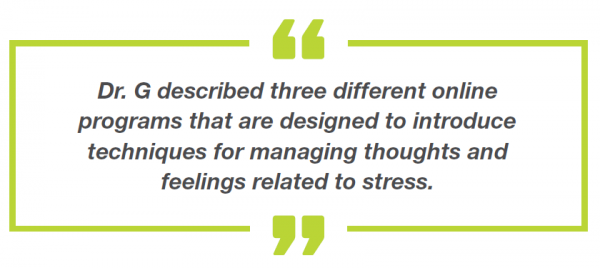I Really Like Having This Plan – A Client Perspective
When students present at walk-in clinics, they are typically seen within two hours, and often within the first hour. Although most students prefer this same-day service, some opt for scheduling a slot in the first 30 minutes of a three-hour walk-in clinic with wait times typically of two to three weeks. At an initial session, student expectations about treatment are assessed and are sometimes adjusted by briefing them on the stepped care model. Based on a composite drawn from elements of two separate client presentations during a walk-in consultation period, the following is a description of a typical student experience:
Justine arrived at 10:15 on Monday morning requesting counseling services. She indicated that she had not been seen previously at the center and was informed of the walk-in consultation process. She decided to avail of the walk-in service. Justine was provided with an iPad walk-in assessment form which, along with demographic items, included an administration of the BHM-20 outcome tracking measure. She completed the forms within five minutes and at 10:25 a.m., a senior psychologist, Dr. G, serving in the role of primary care mental health consultant, greeted her in the waiting room.
Upon entering the consultation office, Dr. G reviewed the limits of confidentiality and outlined the stepped care model. She explained that the university had recently adopted an innovative system for improving service access, treatment effectiveness and empowerment of students seeking services. She showed a graphical representation of the model and indicated where they were in the process (i.e., walk-in consultation—step 1). Dr. G. said that prior to the adoption of stepped care, wait times were much longer with only two high intensity services available – group and individual therapy. Stepped care she explained, had expanded the options to fit better with wide ranging student needs. Dr. G added that some students, at least initially, prefer to “dip their toes into” the process of change with less intense programs that are educational in nature and self-directed.
Then Dr. G stated that outcome monitoring tools, such as the BHM- 20 that Justine completed in the waiting room, are used to assess and reassess the impact and appropriateness of the programming offered. She added that by reviewing the results today, and on any future visits, they could decide together on treatment options best suited to her circumstances. Before discussing Justine’s BHM-20 results, Dr. G asked if Justine had any questions. Justine replied, “No, it seems to make sense.” Dr. G showed an iPad screen shot of the BHM-20 results to Justine. The results indicated that Justine’s level of distress was moderate with elevations on general and social anxiety. Justine responded “sometimes” to the critical item, “wanting to harm some-one.” When queried, Justine said that her stress was “getting so high” that she was afraid she might get the urge to “cut or scratch” herself like she did during her first year of high school. She clarified that her response was only in reference to harming herself not others.

At this point, Dr. G asked open-ended questions about Justine’s reasons for seeking services. Justine indicated that she had seen a counselor previously at another university and was taking 20 mg of Paxil for anxiety. However, over the past two weeks her symptoms had returned following an argument with her father. Dr. G asked about what had been helpful to her in her previous counseling and Justine said she liked being able to “just talk” but that it didn’t really change her symptoms much. Justine said she really wanted to learn about strategies for relaxing or dealing with her thinking which she said “gets messed up” whenever things get busy or there is conflict. She said that she also feels awkward and nervous in social situations and large spaces. Justine seemed eager for solutions but worried that with her part-time job, full course load and long commute time, she would have a hard time attending regular sessions.
Dr. G described three different online programs that are designed to introduce techniques for managing thoughts and feelings related to stress. Both Dr. G and Justine decided that the low intensity self-help program, WellTrack, would not be enough because Justine expected she would procrastinate without any follow-up. They agreed to try the TAO (therapist assisted online) program because the weekly 15-min coaching sessions could easily fit into her tight schedule and would help motivate her to do the modules and exercises between sessions.
Dr. G said that she thought Justine may also benefit in the future from a therapy group for anxiety but wondered aloud if this might be too intensive and anxiety provoking for Justine right now. Justine agreed, saying, “I could never talk about this in front of a group of strangers.” Dr. G said, “The TAO program is a good choice right now and would likely reduce your anxiety.” She added, “The group might be an option once you pick up some of the basic CBT skills through TAO.” Justine seemed uncertain but agreed it was a possibility.
Dr. G wrote the plan out on a “behavioral prescription” pad checking off the box beside the midlevel TAO program as a first step and putting a question mark beside the high intensity group therapy box for the anxiety group as an option for the future. She showed Justine a copy and asked her how she felt about the plan. Justine said she was pleased with it. Dr. G informed Justine that an email invitation would come from TAO-connect later that day. Below her name on the plan, Dr. G wrote down her contact information and encouraged Justine to reconnect at any time if she wished to adjust the plan. She scheduled an appointment for the first 15-min TAO coaching session for the following week. Justine smiled, holding up the prescription, as she reached for the door and said, “I really like having this plan.”

